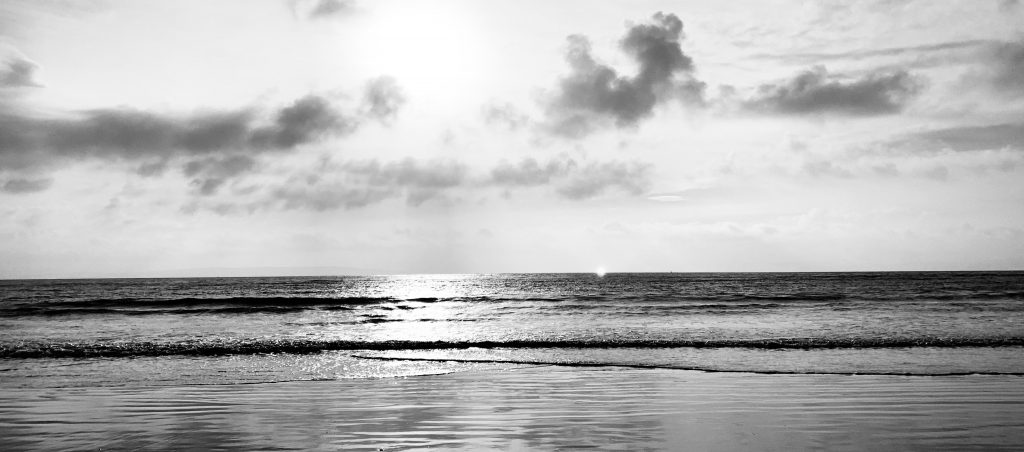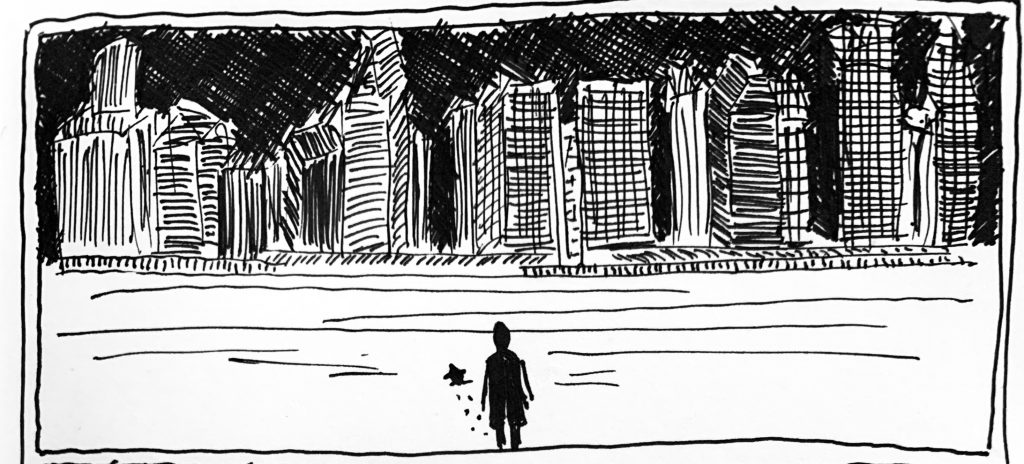Andy Warhol wrote a book called THE Philosophy of Andy Warhol (From A to B and Back Again) published in 1975 and as you might expect, it’s a bit of a strange read. It’s definitely not a book that takes you in a straight line from A to B. It’s more of a peek into a very singular imagination. One which you can easily get lost in. On the contents page of the book at the very top is the phrase “You Can’t Argue with Your Scrapbook” (I like that EVERY word is capitalised even in the contents section – it gives you an immediate sense of the importance of the ramblings that are to follow… ) and this is very much what this post is going to be like. A walk through of some pages of my scrapbook, sorry, My Scrapbook, about how we experience spaces, particularly urban spaces and to think about an embodied perspective as well as a technologically mediated one. I’m thinking about why how we perceive and interact with our environment matters and how it can become an act of resistance. Curiosity v capitalist conformity if you like.
It was this tweet that brought these ideas back to the forefront of my mind:
Do any of you still allow yourself to get “lost” driving in a city (either your own or one that’s new to you)? Or, do any of you explore a city w/o using some mapping tool?
— Porch Pirate Booty (@hypervisible) 14 December 2019
The thread of all the answers makes for interesting reading. Although the idea of getting lost by car feels like an America’s concept to me. I am not sure most of the places I drive to are big enough to get lost in on purpose or with fun to be had (unless you count British one way systems). But the tweet struck a real chord with me because I feel that in this age of search and GPS getting lost is underrated. Whenever I see a tourist navigating Oxford or London with their phone held at eye level, staring with concentration at the street-view of where they are, reading the notifications that pop up about buildings and sights as they pass, I wish they would put the phone away and look around instead. I wish they would follow their feet and experience the place for themselves and discover makes them curious. Not to follow a predetermined route or learn only about what others or an algorithm deem important.
There are three concepts/metaphors related to getting lost and walking in the city that I am interested in: the slow walk or ‘ flanerie’ through the city that Benjamin and Baudelaire wrote about, the ‘derive’, that drifting through urban space that Guy Debord first wrote of and that was an important part of the Situationist International movement and the embodied practice of exploring a place with all our senses engaged to create a phenomenological perspective which is often associated with studying landscapes in Anthropology and Archaeology.
As an aside, as I mentioned in the introduction to this series, I really need to find some more diverse references for these ideas and concepts. The current list is only a starting point – I did create the Neon Flaneuse not a Flaneur intentionally. Suggestions and links via Twitter to @neonFlaneuse would be gratefully received.
Anyway, let’s get back to The Scrapbook and why these three concepts can be useful to think with now, in our context:
Phenomenological studies of prehistoric landscapes may not immediately spring to mind as an obvious reference point… but how we create meaning through our experience of a particular place and what mediates that experience is highly relevant to our relationship to technology. It helps articulate the contested, shifting nature of places and encourages us to consider the limitations of what we can capture about a place or an object (in images or words or other data). Placing primary focus on human experience, our individual points of view, presents an interesting challenge to data driven narratives.
The following two quotes give you a better idea (feel free to skip this bit, it gets less dense again further down). The first one is by Barbara Bender (2006) , an Archaeologist and Anthropologist who wrote much about landscapes but her work could be equally applied to cityscapes and urban sprawls:
‘Landscape’ is . . . ‘the world out there’ as understood, experienced, and engaged with through human consciousness and active involvement. Thus it is a subjective notion, and being subjective and open to many understandings it is volatile.’
The second quote is from Chris Tilley, who alongside Barbara Bender was at the Department of Anthropology at UCL when I was a student there and my PhD supervisor.
He talks about how we as human beings experience things, places or objects, through our senses, i.e. an embodied perspective, shaped by our physical bodies. He argues in his introduction to Identity, Place, Landscape and Heritage (2006) that ‘as our ‘involvement in the world is always situated as taking place from a point of view’ and also situated in time what we can capture and communicate is necessarily limited. Or, as he puts it,
‘The body is both interpretational constraint and enabling condition for the construction of meaning.’
If you don’t find this kind of phrasing particularly accessible, then you know now what my years as a research student were like.
What is relevant to me is that a lot of technology places an emphasis on only one of our senses, the visual, and often neglects all the others. This doesn’t just hold true for how we use tech but also extends to representations of the world that are based on data we collect, on words and images and other information. So if I walk down a street and I smell a bakery, I might go there and buy a donut. A drone wouldn’t. What smells delicious to me may not appeal to you. What feels like a steep climb or a tall step or a big jump to me… may be perceived differently by someone who is taller or stronger or braver. My primary way of making my way through the world is to rely on my body, hence it enables me to make sense of the world. And as there is no other way for me to be alive (AI evangelists need not apply here) it is also a constraint, i.e. the only way for me to make sense of the world.
Add to that all that ‘being me’ brings with it and add that to the way I interact with the world or with particular places and then multiply by all the other people on the planet and you get what Barbara Bender means when she says our involvement in the world is always situated.
Complicated quotes aside, the situatedness of human experience is a concept that is very relevant to human-computer interaction. Without sufficiently being able to understand and plan for that element of human social interaction problems of mutual intelligibility arise, and Anthropologist Lucy A. Suchman has written much on this subject, including this book which I will be adding to my reading list (and which I came across in a post on situated degree pathways – thanks 🙂 )
Already 1,000 words written and lots of obscure references thrown in and I haven’t even gotten to the second idea I wanted to discuss yet. I am not sure that bodes well for this new blogging venture, but we made it to the beach now in any case… .

Another book I came across (and which is now on my reading list) is The Beach Beneath the Street – The Everyday Life and Glorious Times of the Situationist International by McKenzie Wark. According to Wikipedia, McKenzie Wark is Professor of Media and Cultural Studies at The New School in New York City. Wark’s work sounds really interesting and whilst I have come across some of her writing on technology, there is clearly a lot more to discover.
Thanks to Wikipedia (and as I don’t have any of the source materials to hand) you can read a very comprehensive summary of what the Situationist International movement was all about. Although its active period as an artistic and later political movement (1950s-1970s) is behind us, its critique of advanced capitalism is directly related to the concerns about surveillance capitalism, social alienation and passive consumption that we currently discuss. The beach metaphor comes into it in relation to ‘situations, moments of life deliberately constructed for the purpose of reawakening and pursuing authentic desires, experiencing the feeling of life and adventure, and the liberation of everyday life’.
Drifting through the city, following wherever your feet may take you, stepping off the map, getting lost in the sprawl of the metropolis… following your curiosity. Taking time, being present. Not being tracked. If the Situationist International movement was revived today it would probably be a mindfulness tracking app with ethical, vegan wellbeing product tie-ins on Instagram. I don’t want to look for it in case there already is one.
But the radical vision at the heart of the movement, the anger and resistance that found its expression in the insurrections in France in May 1968, must not be lost. The desire to be liberated from the capitalist quotidian, to find alternatives to the prevailing social and economic narrative, is now more relevant than ever. Looking up, reclaiming our streets and cities from row upon row of homogenous shops and offices for communities not corporations is a fight to be fought now as it was then.
But there is no time as we are on our way to 10,000 steps a day. No time to stop, slow down.
Which is where the Neon Flaneuse and its origin come in.
I imagine, that if you were invited for tea by the heroine of my story (she only drinks Lady Grey, in case you are wondering) and had a look at her bookshelves, you’d find a book that every self respecting Flaneur ought to own: Momo by Michael Ende. Published in 1973, one of the book’s themes is the commodification of time, but it also features a ‘living doll’ and many other technologies which a few decades later read like an edtech development plan or marketing manual (not a lot has been written about Momo, but this article in Kronoscope contains a useful summary).
One of the main characters in the book is the tortoise Cassiopeia, a magical tortoise which can communicate through words that appear in glowing letters on her back: FOLLOW ME.
By following the tortoise, and walking at the pace of the tortoise instead of rushing faster and faster, the girl Momo makes her way to try and save the world. The pace of the tortoise is important in the story, and as a metaphor it resonates with the concept of “flanerie”, of slowly walking through the city. The pace at which you may perceive and discover things, get lost and drift for a while.
It’s a romantic metaphor I admit, but it is also a radical one. It is radical in part because it rejects our path as a linear narrative from A to B, it rejects conformity in favour of curiosity. It is radical because it is about stepping off the grid and onto the beach, to really look. Perception that may lead to reflection and resistance.

Soundtrack for this post:
Heart of Gold by Neil Young and his album On the Beach.
Also…